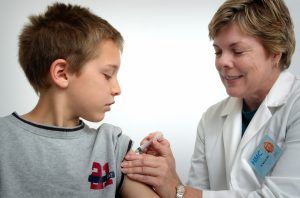Vaccines Are Vital for Healthy Kids
Kids are returning to school and playgrounds. So are childhood diseases.
 Pediatric immunizations have changed the world! Parents used to live in fear of their child getting common diseases that could kill, blind, disfigure or disable their child. Even for kids who were not severely affected, these diseases still cost lots of missed school, medical bills and missed work for parents.
Pediatric immunizations have changed the world! Parents used to live in fear of their child getting common diseases that could kill, blind, disfigure or disable their child. Even for kids who were not severely affected, these diseases still cost lots of missed school, medical bills and missed work for parents.
Thanks to some amazing vaccines, most of these illnesses have become rare in our country.
Importance of Vaccines
Some parents were afraid to bring their child to the doctor’s office for routine visits early on during the Covid pandemic. That was understandable then. But this delay put many children behind in getting all their needed vaccinations.
As children return to their usual activities, common illnesses have also quickly returned. Those common childhood illnesses that are preventable with vaccines will also now increase if we don’t improve current immunization rates.
The diseases that we immunize against are still out there and will spread if children are not protected. Some parents I talk to don’t think children are at risk of getting these diseases because they believe the diseases don’t happen in our country.
While infections from illnesses like measles are uncommon in the U.S., they do happen. In the past few years, I’ve diagnosed children in my practice with pertussis (whooping cough), varicella (chicken pox) and mumps — all of which have highly effective vaccines.
Measles – A Cautionary Tale
Vaccines can be highly effective, but none offer 100% protection. It’s important that the majority of children be immunized to prevent spread to those who are not or cannot be immunized (for example, because they have an illness such as leukemia).
For highly contagious diseases, like measles, we need at least 95% of people vaccinated to prevent an outbreak — for so-called herd immunity. Unfortunately, there have been measles outbreaks in the U.S. in communities with low immunization rates. According to the CDC, we had 704 cases of measles in 2019 — that’s before the pandemic — which was the highest number since 1994. And almost all those cases were in unvaccinated people.
This is very concerning, as we are now dealing with growing pockets of unvaccinated children.
Vaccines are Safe
Some parents worry that vaccines are more dangerous than the diseases they prevent. Part of this belief is because vaccines have been so successful that parents don’t have personal experiences with these diseases.
When I was younger, my cousin was hospitalized with epiglottis and needed a hole in her trachea to breathe. Her condition was caused by Haemophiles influenza type b infection. Thanks to an immunization that came out shortly after (Hib vaccine), I’ve never had a patient with that illness. And most parents today don’t worry their child will get my cousin’s disease.
All vaccines given to children go through a long process to confirm they work and are safe. Once vaccines are licensed, they are continually monitored for adverse reactions that may not have been detected in the initial studies. When concerns were brought up that vaccines like the MMR caused autism, studies were undertaken to evaluate this concern. The medical community found strong evidence that vaccines do not cause autism.
Vaccines for Each Age
We start protecting children just after birth with the hepatitis B vaccine because the disease can be contracted at birth. Babies require two more doses, between the ages of 1 and 6 months, for protection.
Then at the 2-month visit, we give multiple vaccines. Injections that contain multiple vaccines are used in as few as two needles to protect against eight different diseases, and one vaccine is given orally.
These vaccines are repeated at 4 and 6 months of age. The child is not fully protected until the complete series of vaccinations is done. Children get booster doses of some of these vaccines again between 12 and 15 months, and then between 4 and 5 years of age.
The illnesses we immunize against are diphtheria, pertussis (whooping cough), tetanus, polio, Haemophilius b, hepatits B, rotavirus and pneumococcal disease. Pneumococcal disease can cause sepsis, pneumonia, meningitis and ear infections. Rotavirus causes a diarrheal illness, and the vaccine to prevent it is the only one we currently give by mouth.
Here is a recap of immunizations your child needs, starting at 1 year old.
- At the age of 1, children are given the MMR (measles, mumps, rubella) vaccine and varicella vaccine (chicken pox). Bosster doses are needed between the ages of 4 and 5 years.
- Hepatitis A vaccine is given in two doses at 12–15 months and 18–24 months. Some teenagers may not have been given this as infants and should get caught up at this point. Hep A causes outbreaks every year, including a recent case connected to contaminated strawberries.
- At 11, children should be boosted with the tetanus and pertussis (Tdap), meningitis ACWY and HPV vaccines. HPV is a vaccine to prevent cervical cancer and genital warts. A second dose is needed six months later. It’s recommended for both girls and boys.
- At 16, teens need a meningitis ACWY booster vaccine and can discuss the option of meningitis B vaccine with their doctor.
- Influenza vaccine is recommended for children starting at 6 months of age. For the first season they get it, they need a second dose one month later. Then they should get a single dose every fall.
You can find out more information about each shot, possible side effects and when to get them at CDC.gov. Parents can learn more about the diseases the vaccines prevent from sites like CDC.gov or HealthyChildren.org.
In summary, vaccines are safe and effective. As a mother and a doctor, I felt very comfortable getting my own children immunized and recommending vaccinations for my patients.
 Dr. Kudes is a board-certified pediatrician who’s practiced at Suburban Family Medicine for 15 years. She completed her medical education at Temple University and her residency at Golisano Children’s Hospital. She’s part of the teaching faculty at the Suburban Family Medicine Residency program, clinical assistant professor in the Department of Pediatrics at PCOM and a member of the PA American Academy of Pediatrics School Health Committee. SuburbanHosp.org.
Dr. Kudes is a board-certified pediatrician who’s practiced at Suburban Family Medicine for 15 years. She completed her medical education at Temple University and her residency at Golisano Children’s Hospital. She’s part of the teaching faculty at the Suburban Family Medicine Residency program, clinical assistant professor in the Department of Pediatrics at PCOM and a member of the PA American Academy of Pediatrics School Health Committee. SuburbanHosp.org.
